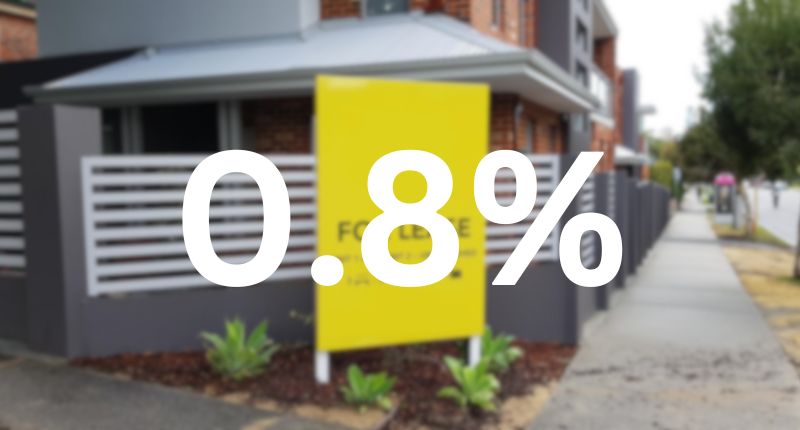
- Australia's vacancy rate remained at 0.8% for the third month in a row.
- East coast capitals saw vacancies ease over November.
- The Perth and Adelaide markets remained tight at 0.3%.
Australia’s rental market remains tight, with the latest Domain figures showing vacancy rates remained at 0.8% for the third consecutive month.
While it remains a challenge to find a rental property in Australia, the story varies across the country.
“While the rental market continues to be a landlord’s market, we are seeing signs of stabilising conditions in some markets – Sydney, Melbourne, and Brisbane [are] experiencing a slight increase in vacancy rates,” said Domain’s chief of research and economics, Dr Nicola Powell.
“In the coming months, while we do expect to see a seasonal lift in vacancy rates as rental supply traditionally increases, it will be met with higher demands as the changeover period kicks off.”
The three aforementioned east coast capitals all recorded increases to their vacancy rates. Sydney and Melbourne both saw vacancy rates move from 0.9% in October to 1% in November. Brisbane likewise recorded a 0.1 percentage point rise, up from 0.8% in October to 0.9% in November.
Australian vacancy rates for November 2023
| November 2023 | October 2023 | November 2022 | Monthly change | Annual change | |
| National | 0.8% | 0.8% | 0.8% | – | – |
| Combined Capitals | 0.8% | 0.8% | 0.9% | – | ↓ |
| Combined Regionals | 0.8% | 0.8% | 0.7% | – | ↑ |
| Sydney | 1.0% | 0.9% | 1.1% | ↑ | ↓ |
| Melbourne | 1.0% | 0.9% | 1.1% | ↑ | ↓ |
| Brisbane | 0.9% | 0.8% | 0.7% | ↑ | ↑ |
| Perth | 0.3% | 0.3% | 0.3% | – | – |
| Adelaide | 0.3% | 0.3% | 0.3% | – | – |
| Hobart | 0.8% | 0.9% | 0.4% | ↓ | ↑ |
| Canberra | 1.4% | 1.6% | 1.2% | ↓ | ↑ |
| Darwin | 1.5% | 1.2% | 0.9% | ↑ | ↑ |
Source: Domain.
Sydney’s rise in available rentals is the first since June, with Domain noting the change was driven by an increase in rental supply. The number of people looking for a rental has also dipped, with average views per rental listing declining over November; nationally, average views per rental listing also declined.
The Melburnian rise in vacancy rates was also the first since June, and similarly caused by an increase in available rentals.
Vacancy rates in Brisbane are at an 11 month high, following its second consecutive monthly rise in vacancy rates. The report noted this potentially indicates a stabilising rental market.
Perth and Adelaide remain the tightest rental markets in the country, both recording rental vacancy rates of 0.3%. It is the four consecutive month these cities have been sitting at that level of rental availability, with a large boost to supply needed to affect any change to local rental markets.
Hobart and Canberra both recorded drops in their rental vacancies.
Australian city areas with the highest vacancy rates for November 2023
| Rank | Sydney | Melbourne | Brisbane & Gold Coast | Perth | Adelaide |
| 1 | Dural – Wisemans Ferry (2.6%) | Melbourne City (3.1%) | Jimboomba (1.8%) | Serpentine – Jarrahdale (0.7%) | Adelaide City (0.6%) |
| 2 | Rouse Hill – McGraths Hill (2.2%) | Stonnington – East (2%) | Browns Plains (1.6%) | Mandurah (0.7%) | Burnside (0.6%) |
| 3 | Ku-ring-gai (2%) | Whitehorse – West (1.7%) | Rocklea – Acacia Ridge (1.5%) | Armadale (0.6%) | Unley (0.6%) |
| 4 | Blacktown – North (1.8%) | Melton – Bacchus Marsh (1.5%) | Gold Coast Hinterland (1.4%) | Cottesloe – Claremont (0.5%) | Adelaide Hills (0.5%) |
| 5 | Pittwater (1.8%) | Boroondara (1.2%) | Kenmore – Brookfield – Moggill (1.4%) | Perth City (0.5%) | Norwood – Payneham – St Peters (0.5%) |
Source: Domain.
At a glance, some Australia’s lowest vacancy rates appeared across both relatively affordable locations and more popular areas.
Perth’s Kalamunda remained among the tightest suburbs, frequently featuring among the tightest vacancy rates in the western capital. There were points where Kalamunda simply had no rentals on the market.
Australian city areas with the lowest vacancy rates for November 2023
| Rank | Sydney | Melbourne | Brisbane & Gold Coast | Perth | Adelaide |
| 1 | Richmond – Windsor (0.2%) | Manningham – East (0.1%) | Strathpine (0.3%) | Kalamunda (0.1%) | Tea Tree Gully (0.1%) |
| 2 | Sutherland – Menai – Heathcote (0.2%) | Nillumbik – Kinglake (0.1%) | Southport (0.4%) | Belmont – Victoria Park (0.2%) | Marion (0.2%) |
| 3 | Bankstown (0.3%) | Knox (0.3%) | North Lakes (0.4%) | Bayswater – Bassendean (0.2%) | Port Adelaide – East (0.2%) |
| 4 | Camden (0.3%) | Darebin – South (0.3%) | Gold Coast – North (0.4%) | Stirling (0.2%) | Salisbury (0.2%) |
| 5 | Campbelltown (NSW) (0.4%) | Yarra Ranges (0.4%) | Robina (0.4%) | Cockburn (0.2%) | Onkaparinga (0.2%) |
Source: Domain.
Will the market continue to improve next year?
“It has certainly been a tough year for renters. In 2024, we do anticipate the rental market to reach a tipping point driven by stretched affordability,” said Dr Powell.
“More renters opting for house shares and first-home buyer incentives will help transition some to being owners or fast-track others to a more affordable purchase,” she added.
This is also one of the five trend predictions for 2024.







